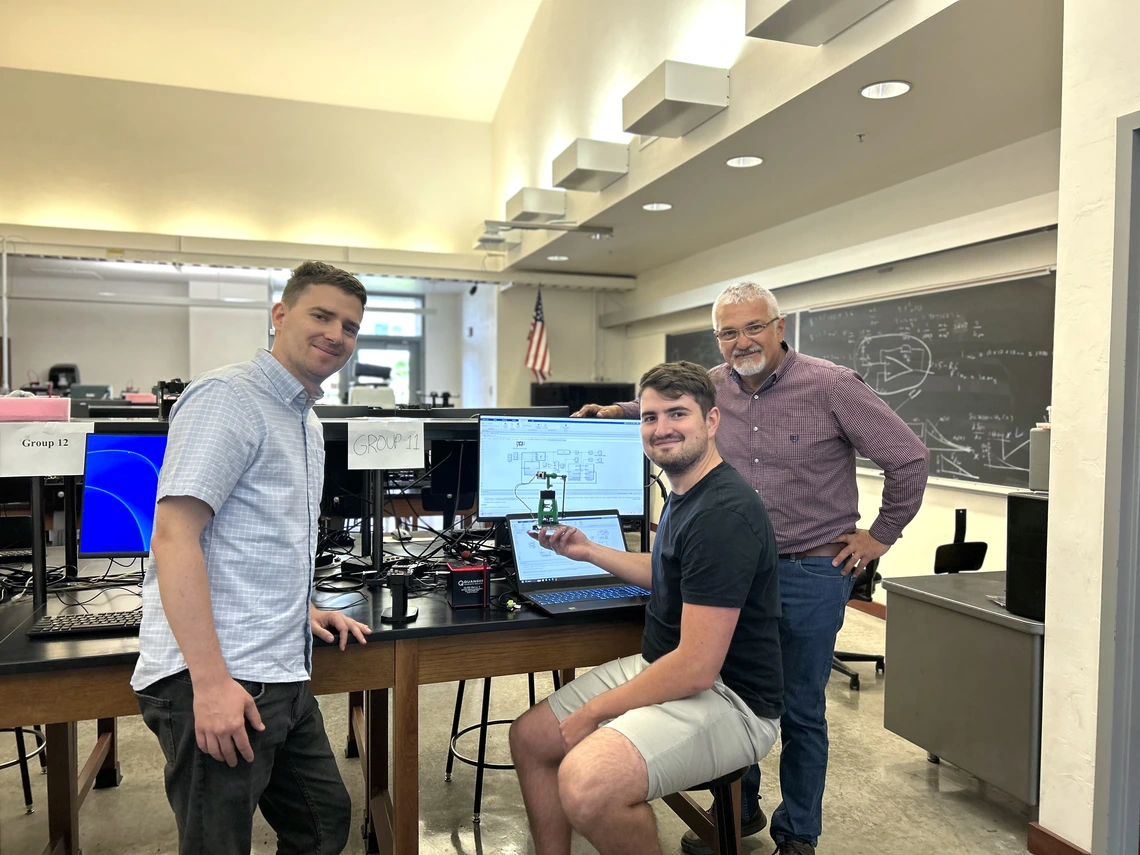Enikov's collaborative paper earns IEEE recognition

(From left) STUBA professor Martin Gulan, master's student Michal Paučo and AME professor Eniko Enikov demonstrate BicopShield.
Eniko Enikov, professor of aerospace and mechanical engineering at the University of Arizona, co-authored a paper with Martin Gulan and Ján Boldocky of the Slovak University of Technology (STUBA) that earned international recognition at the 2025 IEEE Global Education Conference (EDUCON) in London this April.
The paper “BicopShield: A Twin-Rotor Portable Laboratory for Control Engineering Education” received the Best Paper Award in the Non-Traditional Lab Concepts category.
BicopShield is a small, table-top device with dual spinning rotors that resembles a miniature helicopter arm. Constructed from 3D-printed parts and standard electronic components, it’s easy to assemble, open-source and costs around $30 to build, making it ideal for university laboratories.
“Receiving the Best Paper Award was a very rewarding moment,” said Gulan, an associate professor of mechanical engineering at STUBA. “While BicopShield itself is a recent development, the recognition reflects the strength of a broader academic partnership and our shared commitment to accessible, hands-on engineering education.”
The device is part of the AutomationShield family – an open-source platform that offers unified software libraries, exercises and documentation for control engineering education – which shows college instructors how to integrate BicopShield into their courses and allows students to begin experimenting with minimal setup.
14 years of cooperation
The university partnership began in 2011, when Gulan first visited the U of A as an applied mechanics master’s student to work as a visiting research scholar supervised by Enikov. The two shared an affinity for the advancement of hands-on education, and kept in close contact following Gulan’s departure in 2012.
The two universities signed a bilateral exchange program agreement in 2024, which brought Gulan’s PhD student Boldocky into the mix. In September 2024, they began work on the BicopShield to demonstrate abstract concepts with hands-on, interactive learning.
Students can adjust the speed of the rotors by inputting simple code on an Arduino board. Code commands the device to balance the arm or make it reach and hold a steady position, exposing students to challenges encountered in drones or other rotorcraft. Additionally, students build mathematical models and adjust controllers based on real-time data.
Helping students thrive
The BicopShield project is just one example of how the partnership bolsters student success.
Early this year, Michal Paučo, a mechanical engineering master’s student of Gulan at STUBA, completed a three-month research internship at AME, co-supervised by Enikov and supported by the National Scholarship Programme of the Slovak Republic.
During his time at U of A, Paučo developed the FurutaShield – an addition to the AutomationShield family – and presented it as part of his master’s thesis in June.
“In many ways, this mirrors my own experience from 2011,” Gulan said.
Doctoral students have also benefited.
“Over the years, the collaboration with STUBA has led to two PhD students who completed their doctoral degrees, Gergo Edes and Rudolf Kyselica,” Enikov said.
Gulan said he wants the collaboration to continue to support student mobility, joint research activities and curriculum innovation.
“This recognition affirms that efforts to democratize engineering education by making it more flexible, replicable and affordable are both timely and impactful,” he added. “We are honored that our joint contribution was acknowledged by the EDUCON community.
